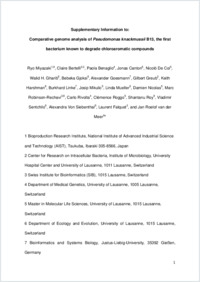Comparative genome analysis of Pseudomonas knackmussii B13, the first bacterium known to degrade chloroaromatic compounds
- Miyazaki, Ryo Bioproduction Research Institute, National Institute of Advanced Industrial Science and Technology (AIST), Tsukuba, Ibaraki, Japan - Department of Fundamental Microbiology, University of Lausanne, Switzerland
- Bertelli, Claire Center for Research on Intracellular Bacteria, Institute of Microbiology, University Hospital Center and University of Lausanne, Switzerland - Swiss Institute for Bioinformatics (SIB), Lausanne, Switzerland
- Benaglio, Paola Departments of Medical Genetics, University of Lausanne, Switzerland
- Canton, Jonas Master in Molecular Life Sciences, University of Lausanne, Switzerland
- Coi, Nicoló De Master in Molecular Life Sciences, University of Lausanne, Switzerland
- Gharib, Walid H. Department of Ecology and Evolution, University of Lausanne, Switzerland
- Gjoksi, Bebeka Master in Molecular Life Sciences, University of Lausanne, Switzerland
- Goesmann, Alexander Bioinformatics and Systems Biology, Justus-Liebig-University, Gießen, Germany
- Greub, Gilbert Center for Research on Intracellular Bacteria, Institute of Microbiology, University Hospital Center and University of Lausanne, Switzerland
- Harshman, Keith Lausanne Genomic Technologies Facility, Center for Integrative Genomics, University of Lausanne, Switzerland
- Linke, Burkhard Bioinformatics and Systems Biology, Justus-Liebig-University, Gießen, Germany
- Mikulic, Josip Master in Molecular Life Sciences, University of Lausanne, Switzerland
- Mueller, Linda Master in Molecular Life Sciences, University of Lausanne, Switzerland
- Nicolas, Damien Master in Molecular Life Sciences, University of Lausanne, Switzerland
- Robinson-Rechavi, Marc Swiss Institute for Bioinformatics (SIB), Lausanne, Switzerland - Department of Ecology and Evolution, University of Lausanne, Switzerland
- Rivolta, Carlo Departments of Medical Genetics, University of Lausanne, Switzerland
- Roggo, Clémence Master in Molecular Life Sciences, University of Lausanne, Switzerland
- Roy, Shantanu Department of Fundamental Microbiology, University of Lausanne, Switzerland
- Sentchilo, Vladimir Department of Fundamental Microbiology, University of Lausanne, Switzerland
- Siebenthal, Alexandra Von Master in Molecular Life Sciences, University of Lausanne, Switzerland
- Falquet, Laurent Swiss Institute for Bioinformatics (SIB), Lausanne, Switzerland
- Meer, Jan Roelof van der Department of Fundamental Microbiology, University of Lausanne, Switzerland
-
28.05.2014
Published in:
- Environmental Microbiology. - 2015, vol. 17, no. 1, p. 91-104
English
Pseudomonas knackmussii B13 was the first strain to be isolated in 1974 that could degrade chlorinated aromatic hydrocarbons. This discovery was the prologue for subsequent characterization of numerous bacterial metabolic pathways, for genetic and biochemical studies, and which spurred ideas for pollutant bioremediation. In this study, we determined the complete genome sequence of B13 using next generation sequencing technologies and optical mapping. Genome annotation indicated that B13 has a variety of metabolic pathways for degrading monoaromatic hydrocarbons including chlorobenzoate, aminophenol, anthranilate and hydroxyquinol, but not polyaromatic compounds. Comparative genome analysis revealed that B13 is closest to Pseudomonas denitrificans and Pseudomonas aeruginosa. The B13 genome contains at least eight genomic islands [prophages and integrative conjugative elements (ICEs)], which were absent in closely related pseudomonads. We confirm that two ICEs are identical copies of the 103 kb self-transmissible element ICEclc that carries the genes for chlorocatechol metabolism. Comparison of ICEclc showed that it is composed of a variable and a ‘core’ region, which is very conserved among proteobacterial genomes, suggesting a widely distributed family of so far uncharacterized ICE. Resequencing of two spontaneous B13 mutants revealed a number of single nucleotide substitutions, as well as excision of a large 220 kb region and a prophage that drastically change the host metabolic capacity and survivability.
- Faculty
- Faculté des sciences et de médecine
- Department
- Département de Biologie
- Language
-
- English
- Classification
- Biological sciences
- License
-
License undefined
- Identifiers
-
- RERO DOC 234304
- DOI 10.1111/1462-2920.12498
- Persistent URL
- https://folia.unifr.ch/unifr/documents/304287
Other files
Statistics
Document views: 136
File downloads:
- pdf: 139
- Supplementary material: 131

